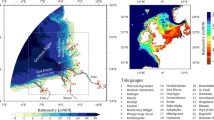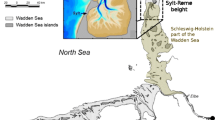Abstract
The response of the tidal system in the southern North Sea to morphodynamic changes was investigated in a modelling study using fine resolution bathymetric observations available for 1982–2011. The Semi-implicit Cross-scale Hydroscience Integrated System Model (SCHISM) was set up for the different sets of bathymetries. One set of bathymetry was compiled from a large number of bathymetric measurements over many years, while the other two reflected bathymetry state in the area of Wadden Sea during 2000 and 2011, respectively. The temporal and spatial evolution of bathymetry was dominated by migration of tidal channels. The M4 tide showed larger sensitivity to bathymetric change in the Wadden Sea than the M2 tide, whereas the structure of the latter remained rather robust. The largest change of the tidal wave due to the differences in bathymetries was located off the North Frisian Wadden Sea. Traces of changes were also found far away from the regions of their origin because the tidal waves in the North Sea propagate the local disturbances basin-wide. This illustrated an efficient physical mechanism of teleconnectivity, i.e. effecting the local responses to the larger-scale or remote change of ocean bottom caused by erosion and deposition. The tidal distortion resulting from the relatively small bathymetric changes was substantial, particularly in the coastal zone. This is a manifestation of the nonlinear tidal transformation in shallow oceans and is crucial for the sediment transport and the morphodynamic feedback, because of the altered tidal asymmetry.












Similar content being viewed by others
References
Blanc F (2008) Myocean information system. In: EuroGOOS conference proceedings
Dronkers J (1986) Tidal asymmetry and estuarine morphology. Neth J Sea Res 20(2):117–131
Dronkers JJ (1964) Tidal computations in rivers and coastal waters
Ezer T, Liu H (2010) On the dynamics and morphology of extensive tidal mudflats: integrating remote sensing data with an inundation model of Cook Inlet, Alaska. Ocean Dyn 60:1307–1318. doi:10.1007/s10236-010-0319-x
Friedrichs C T, Aubrey D G (1988) Non-linear tidal distortion in shallow well-mixed estuaries: a synthesis. Estuar Coast Shelf Sci 27(5):521–545
Garcia I D, El Serafy G, Heemink A, Schuttelaars H (2013) Towards a data assimilation system for morphodynamic modeling: bathymetric data assimilation for wave property estimation. Ocean Dyn 63(5):489–505
Gräwe U, Burchard H, Müller M, Schuttelaars HM (2014) Seasonal variability in M2 and M4 tidal constituents and its implications for the coastal residual sediment transport 41. doi:10.1002/2014GL060517
Grohmann C, Smith M, Riccomini C (2009) Surface roughness of topography: a multi-scale analysis of landform elements in midland valley, Scotland. Proc Geomorphom 2009:140–148
Heemink A W, Mouthaan E E A, Roest M R T, Vollebregt E A H, Robaczewska K B, Verlaan M (2002) Inverse 3D shallow water flow modelling of the continental shelf. Cont Shelf Res 22:465–484. doi:10.1016/S0278-4343(01)00071-1
Heyer H, Schrottke K (2013) Aufbau von integrierten modellsystemen zur analyse der langfristigen morphodynamik in der deutschen bucht–aufmod
Hirose N (2005) Least-squares estimation of bottom topography using horizontal velocity measurements in the Tsushima/Korea Straits. J Oceanograp 61:789–794. doi:10.1007/s10872-005-0085-4
IOC, IHO, BODC (2003) Centenary edition of the gebco digital atlas, published on cd-rom on behalf of the intergovernmental oceanographic commission and the international hydrographic organization as part of the general bathymetric chart of the oceans. British oceanographic data centre, Liverpool
Janssen F, Schrum C, Backhaus J (1999) A climatological data set of temperature and salinity for the baltic sea and the north sea. Deutsche Hydrografische Zeitschrift 51(9):5–245. doi:10.1007/BF02933676
Le Provost C, Lyard F, de Midi-Pyrénées O (2003) The impact of ocean bottom morphology on the modelling of the long gravity waves, from tides and tsunami to climate. Charting the Secret World of the Ocean Floor The Gebco Project 1903
Losch M, Wunsch C (2003) Bottom topography as a control variable in an ocean model. J Atmosph Ocean Technol 20:1685–1696. doi:10.1175/1520-0426(2003)020%3C1685:BTAACV%3E2.0.CO;2
Maas L M (1998) On an oscillator equation for tides in almost enclosed basins of non-uniform depth. In: Dronkers J, Scheffers M (eds) Physics of estuaries and coastal seas. Balkema, Rotterdam, pp 127–132
Manning R, Griffith J P, Pigot T, Vernon-Harcourt LF (1890) On the flow of water in open channels and pipes
Mourre B, De Mey P, Lyard F, Le Provost C (2004) Assimilation of sea level data over continental shelves: an ensemble method for the exploration of model errors due to uncertainties in bathymetry. Dyn Atmosph Oceans 38:93–121. doi:10.1016/j.dynatmoce.2004.09.001
Mudersbach C, Wahl T, Haigh I D, Jensen J (2013) Trends in high sea levels of german north sea gauges compared to regional mean sea level changes. Cont Shelf Res 65:111–120
Müller M (2012) The influence of changing stratification conditions on barotropic tidal transport and its implications for seasonal and secular changes of tides. Cont Shelf Res 47:107–118
O’Dea E J, Arnold A K, Edwards K P, Furner R, Hyder P, Martin M J, Siddorn J R, Storkey D, While J, Holt J T, Liu H (2012) An operational ocean forecast system incorporating NEMO and SST data assimilation for the tidally driven European North-West shelf. J Oper Oceanograp 5:3–17
Parker BB (1991) The relative importance of the various nonlinear mechanisms in a wide range of tidal interactions (review)
Pawlowicz R, Beardsley B, Lentz S (2002) Classical tidal harmonic analysis including error estimates in MATLAB using TDE. Comput Geosci 28:929–937. doi:10.1016/S0098-3004(02)00013-4
Pingree R, Griffiths D (1979) Sand transport paths around the british isles resulting from m 2 and m 4 tidal interactions. J Marine Biol Assoc UK 59(02):497–513
Proudman J, Doodson A T (1924) The principal constituent of the tides of the north sea. Philosoph Trans Royal Soc London Series A Containing Papers Math Physl Character:185–219
Robins P E, Davies A G (2010) Morphological controls in sandy estuaries: the influence of tidal flats and bathymetry on sediment transport. Ocean Dyn 60:503–517. doi:10.1007/s10236-010-0268-4
Schulz-Stellenfleth J, Stanev EV (2015) Analysis of the upscaling problem—a case study for the barotropic dynamics in the north sea and the german bight. Ocean Modell (submitted paper)
Scott T R, Mason D C (2007) Data assimilation for a coastal area morphodynamic model: Morecambe Bay. Coast Eng 54:91–109. doi:10.1016/j.coastaleng.2006.08.008
Smith P J, Dance S L, Baines M J, Nichols N K, Scott T R (2009) Variational data assimilation for parameter estimation: application to a simple morphodynamic model. Ocean Dyn 59(5):697– 708
Speer P, Aubrey D (1985) A study of non-linear tidal propagation in shallow inlet/estuarine systems part ii: theory. Estuar Coast Shelf Sci 21(2):207–224
Speer P E (1984) Tidal distrortion in shallow estuaries. PhD thesis, Woods Hole Oceanographic Institution Ma
Stanev E V, Wolff J O, Burchard H, Bolding K, Flȯser G (2003) On the circulation in the East Frisian Wadden Sea: numerical modeling and data analysis. Ocean Dyn 53 (1):27–51. doi:10.1007/s10236-002-0022-7
Stanev E V, Wolff J O, Brink-Spalink G (2006) On the sensitivity of the sedimentary system in the East Frisian Wadden Sea to sea-level rise and wave-induced bed shear stress. Ocean Dyn 56:266–283. doi:10.1007/s10236-006-0061-6
Stanev E V, Al-Nadhairi R, Staneva J, Schulz-Stellenfleth J, Valle-Levinson A (2014) Tidal wave transformations in the german bight. Ocean Dyn 64(7):951–968
Stanev E V, Lu X, Grashorn S (2015) Physical processes in the transition zone between north sea and baltic sea. Numerical simulations and observations. Ocean Modell 93:56–74
Uehara K, Scourse J D, Horsburgh K J, Lambeck K, Purcell A P (2006) Tidal evolution of the northwest european shelf seas from the last glacial maximum to the present. J Geophys Res Oceans (1978–2012) 111 (C9)
Umlauf L, Burchard H (2003) Reply to: Comments on ’A generic length-scale equation for geophysical turbulence models by L. Kantha and S. Carniel. doi:10.1357/002224003771816016
Walters R (1987) A model for tides and currents in the english channel and southern north sea. Adv Water Resour 10(3):138–148. doi:10.1016/0309-1708(87)90020-0
Winter C (2011) Macro scale morphodynamics of the German North Sea coast. J Coast Res:706–710
Zaron E D, Pradal M A, Miller P D, Blumberg A F, Georgas N, Li W, Cornuelle J M (2011) Bottom topography mapping via nonlinear data assimilation. J Atmosph Ocean Technol 28:1606–1623. doi:10.1175/JTECH-D-11-00070.1
Zhang Y J, Baptista A M (2008) SELFE: a semi-implicit Eulerian-Lagrangian finite-element model for cross-scale ocean circulation. Ocean Modell 21:71–96. doi:10.1016/j.ocemod.2007.11.005
Zhang Y J, Ateljevich E, Yu H C, Wu C H, Jason C (2015a) A new vertical coordinate system for a 3d unstructured-grid model. Ocean Modell 85:16–31
Zhang Y J, Stanev E, Grashorn S (2015b) Seamless cross-scale modelling with schism. Ocean Modell (submitted)
Zhang YJ, Stanev EV, Grashorn S (2015c) Unstructured-grid model for the North Sea and Baltic Sea: validation against observations. Ocean Modell (in press)
Acknowledgments
We are grateful to the reviewers for their constructive and helpful comments. We acknowledge the German Federal Maritime and Hydrographic Agency (BSH), the German Weather Service (DWD), the Federal Waterways and Shipping Administration (WSV), the German Federal Institute of Hydrology (BfG) and the he partners of the AufMod project for the data made available for this study. This research is part of the initiative Earth System Knowledge Platform (ESKP) supported by the Helmholtz-Association. Part of this work was accomplished during the 3rd author’s tenure as a HWK Fellow and financial support by Hanse-Wissenschaftskolleg (HWK, Germany) is gratefully acknowledged.
Author information
Authors and Affiliations
Corresponding author
Additional information
Responsible Editor: Han Winterwerp
Rights and permissions
About this article
Cite this article
Jacob, B., Stanev, E.V. & Zhang, Y.J. Local and remote response of the North Sea dynamics to morphodynamic changes in the Wadden Sea. Ocean Dynamics 66, 671–690 (2016). https://doi.org/10.1007/s10236-016-0949-8
Received:
Accepted:
Published:
Issue Date:
DOI: https://doi.org/10.1007/s10236-016-0949-8




